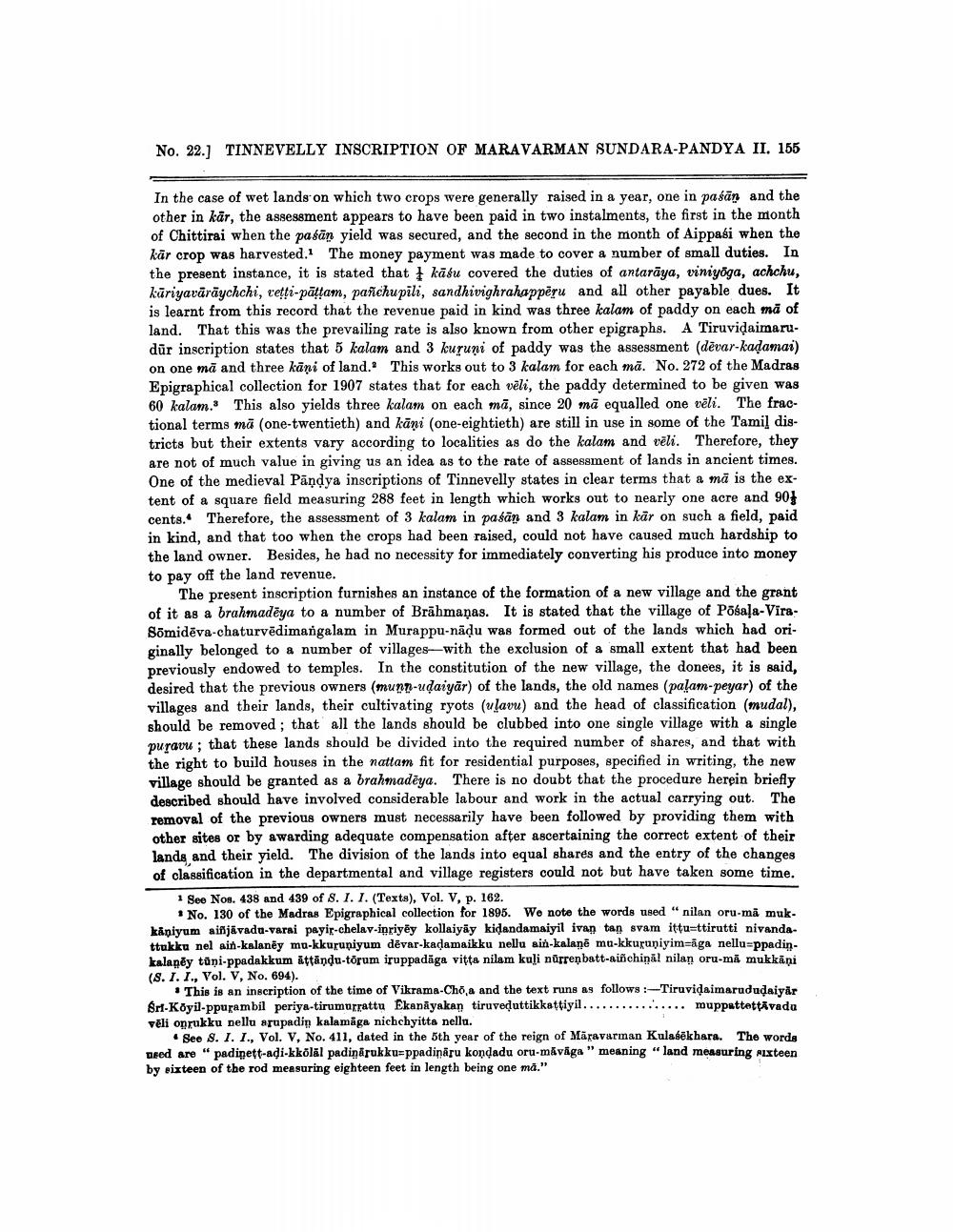________________
No. 22.] TINNEVELLY INSCRIPTION OF MARAVARMAN SUNDARA-PANDYA II. 155
In the case of wet lands on which two crops were generally raised in a year, one in pasān and the other in kär, the assessment appears to have been paid in two instalments, the first in the month of Chittirai when the pasān yield was secured, and the second in the month of Aippasi when the kär crop was harvested. The money payment was made to cover a number of small duties. In the present instance, it is stated that kādu covered the duties of antarāya, viniyoga, achchu, kūriyarārāychchi, cetti-pāttam, pañchu pili, sandhivighrahappēru and all other payable dues. It is learnt from this record that the revenue paid in kind was three kalam of paddy on each mā of land. That this was the prevailing rate is also known from other epigraphs. A Tiruvidaimarudur inscription states that 5 kalam and 3 kuruni of paddy was the assessment (dēvar-kadamai) on one mā and three kani of land. This works out to 3 kalam for each mā. No. 272 of the Madras Epigraphical collection for 1907 states that for each vēli, the paddy determined to be given was 60 kalam. This also yields three kalam on each mā, since 20 mā equalled one vēli. The fractional terms mā (one-twentieth) and kāni (one-eightieth) are still in use in some of the Tamil districts but their extents vary according to localities as do the kalam and vēli. Therefore, they are not of much value in giving us an idea as to the rate of assessment of lands in ancient times. One of the medieval Pandya inscriptions of Tinnevelly states in clear terms that a ma is the extent of a square field measuring 288 feet in length which works out to nearly one acre and 901 cents. Therefore, the assessment of 3 kalam in paśān and 3 kalam in kar on such a field, paid in kind, and that too when the crops had been raised, could not have caused much hardship to the land owner. Besides, he had no necessity for immediately converting his produce into money to pay off the land revenue.
The present inscription furnishes an instance of the formation of a new village and the grant of it as a brahmadēya to a number of Brāhmaṇas. It is stated that the village of Põsala-ViraSömidēva-chaturvēdimangalam in Murappu-nādu was formed out of the lands which had originally belonged to a number of villages with the exclusion of a small extent that had been previously endowed to temples. In the constitution of the new village, the donees, it is said, desired that the previous owners (mund-udaiyar) of the lands, the old names (palam-peyar) of the villages and their lands, their cultivating ryots (ulavu) and the head of classification (mudal), should be removed ; that all the lands should be clubbed into one single village with a single puravu : that these lands should be divided into the required number of shares, and that with the right to build houses in the nattam fit for residential purposes, specified in writing, the new village should be granted as a brahmadēya. There is no doubt that the procedure herein briefly described should have involved considerable labour and work in the actual carrying out. The removal of the previous owners must necessarily have been followed by providing them with other sites or by awarding adequate compensation after ascertaining the correct extent of their lands and their yield. The division of the lands into equal shares and the entry of the changes of classification in the departmental and village registers could not but have taken some time.
1 See Nos. 438 and 439 of 8. I. 1. (Texts), Vol. V, p. 162.
* No. 130 of the Madras Epigraphical collection for 1895. We note the words used "nilan oru-mă muk. kaniyum aifijāvada-varai payir-chelav-inriyėy kollaiyāy kidandamaiyil ivan tan svam ittu=ttirutti nivanda ttukku nelain-kalanēy mu-kkuruniyum dēvar-kadamaikku nellu ain-kalanë mu-kkuruniyim=āga nellusppadinkalanēy tüni-ppadakkum attāndu-törum iruppadäga vitta nilam kuli nürrenbatt-aiñchiņāl nilan oru-ma mukkani (S.I. I., Vol. V, No. 694).
* This is an inscription of the time of Vikrama-Cho,a and the text runs as follows :-Tiruvidaimarududaiyar Srt-Köyil-ppurambil periya-tirumurrattu Ekanayakan tiruveduttikkattiyil................ muppettettivada vēli oprukku nellu arupadin kalamaga nichchyitta nella.
. See 8. I. I., Vol. V, No. 411, dated in the 5th year of the reign of Märavarman Kulasēkhara. The words Deed are "padinett-adi-kkolal padinisukku-ppadināsu kondadu oru-mávaga" meaning " land measuring fixteen by sixteen of the rod measuring eighteen feet in length being one ma."




